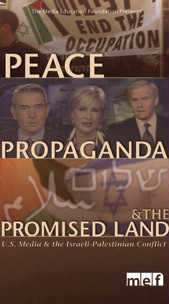In terms of the Israeli-Palestinian conflict, it is not a secret, especially to political junkies, that America falls squarely on the side of Israel. But what about the American media? Sut Jhally (Hijacking Catastrophe, No Logo) and Bathsheba Ratzkoff posit that the American media, both liberal and conservative, also toes the government line. Peace, Propaganda, and the Promised Land is a fascinating documentary that explores if this is indeed the case (not surprisingly, Jhally and Bathsheba claim it is) and why this is the case. Their most important aim is to show that what Americans see on the news may not necessarily be what is true. This is a great film for any policy wonk - it is full of facts, examples, and Jhally and Ratzkoff lay present everything methodically and analytically.
While this is a strength in terms of its content, it makes the film a bit dry, almost like an extended lecture, which will probably turn off those with a passing interest. It does not approach the level of X-Rays of a Lie, which at times was essentially a filmed lecture, because there are plenty of news clips and footage. Jhally and Bathsheba made the correct choice to downplay the volatile emotional aspects of the issue and simply present the facts. With a dry, monotone narration, the barrage of evidence comes across as more powerful.
The largest element missing from American newscasts is context. The filmmakers point out that one of the primary reasons that Palestinians attack Israelis is because Israel is occupying their land, in violation of the UN. It's an issue of causality. The issue is so old, and when one side attacks, the other will retaliate in revenge, forming a never-ending vicious cycle. However, the American media will tend to report it as Palestinians starting, and Israeli troops responding, while failing to mention that the reason that Palestinians attacked is that they are fighting an aggressor on their own territory. American media will humanize fallen Israeli troops while largely ignoring Palestinian casualties. To show how different American reports are, the filmmakers show extended clips of British reports, which attempt to show both sides. It's the "why" question that the Brits pay attention to.
According to Jhally and Ratzkoff, one of the main reasons that American media is pro-Israeli is because of Israeli influence. Lobbying groups like AIPAC (unfortunately, aside from a brief mention, largely unexplored) are extremely powerful and, like all successful lobbying groups, donate to both sides of the aisle. To put it simply, Israel has very good knowledge about the use of politics and marketing in shaping their message. They apply pressure on reporters and newspapers to bend their reporting to match the Israeli agenda. Again, this sounds very conspiracy oriented, but as presented in the film, a highly plausible argument. Heck, even the Israeli press seems to do a more balanced job. Jhally and Ratzkoff also have interviews with pro-peace Israelis, including a few Rabbis. Their claim is that in America, Israel wants to stifle these voices, because it does not present a united front against the Palestinian view. Again, fascinating.
Given the death of Yasser Arafat and the newly reenergized peace process, it would be interesting to see how this movie holds up. It does seem like a case of bad timing, since the very fact that some of the Israelis are pushing for peace undercuts a few of their minor arguments. This reviewer wanted to see even more context in the film. Part of the reason that Americans seem more sympathetic towards Israelis seems to be a matter of historical comfort. The Muslim and/or Arab population in America is relatively small and voiceless, especially when compared to France or Britain. Jews have been in America longer, and are part of its history. This surely has something to do with the issue, but is largely unexplored in Peace, Propaganda, and the Promised Land. But this is a relatively small criticism on an otherwise interesting film.
